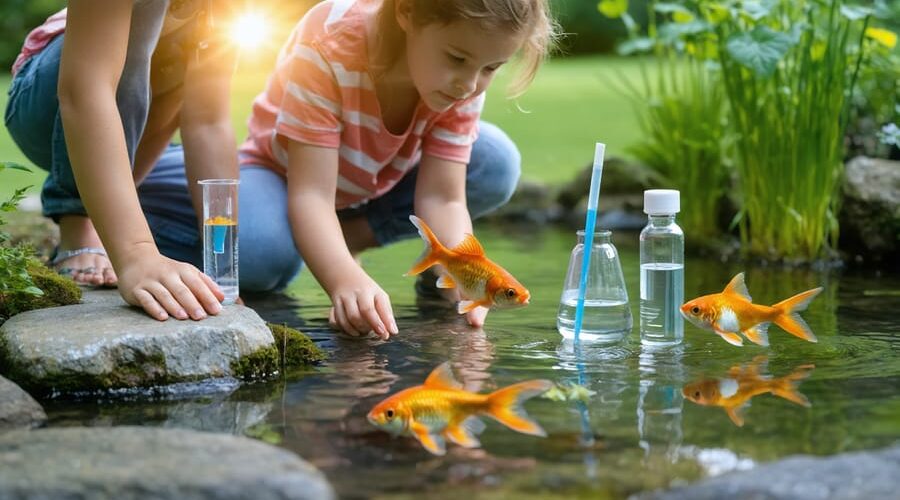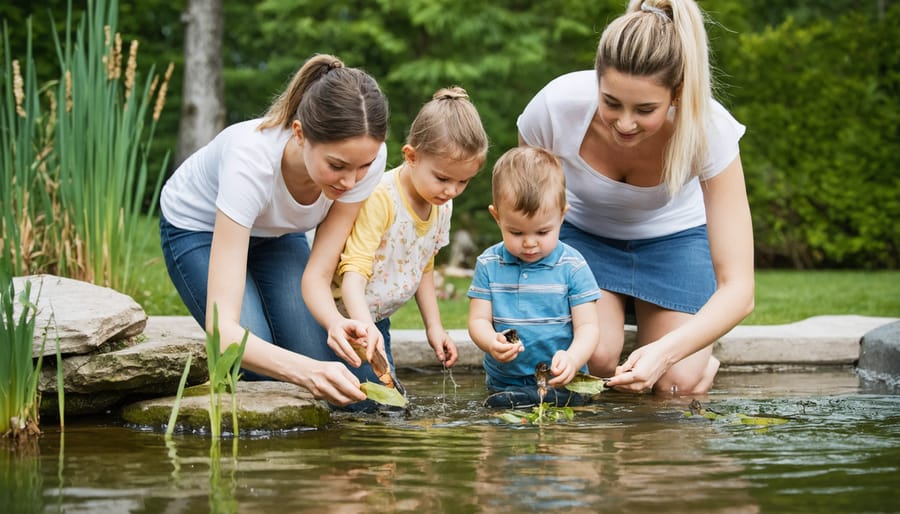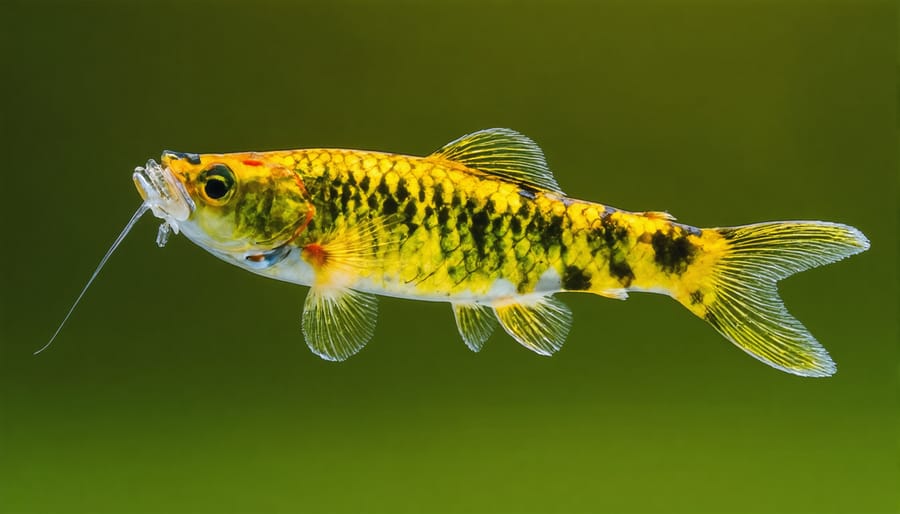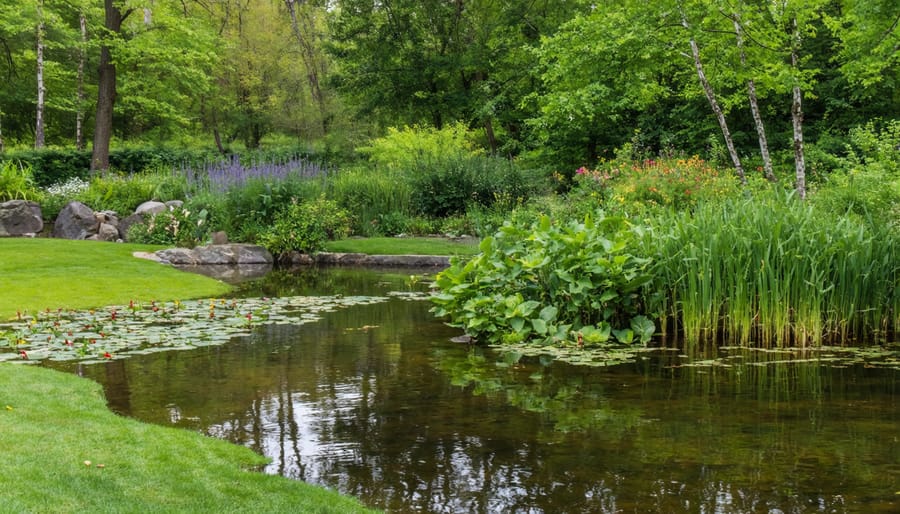
How Project WILD Aquatic Transforms Your Backyard Pond Into a Living Classroom
Transform your backyard pond into an interactive learning space by introducing fish identification activities that help children and adults connect with aquatic life firsthand. Project WILD Aquatic is an award-winning conservation education program that teaches water ecology through hands-on workshops and activities, making it perfect for pond owners who want to deepen their understanding of the ecosystem thriving right in their own garden.
Start by learning to identify the fish species visiting or living in your pond through simple observation techniques. Use a clear viewing tube or lean over the water’s edge during feeding times to spot distinguishing features like body shape, fin placement, and color patterns. Keep a waterproof identification guide nearby or create your own illustrated pond journal documenting each species you discover.
Move beyond passive observation by setting up simple water quality tests that reveal what your fish need to thrive. Test pH levels, temperature, and dissolved oxygen using affordable kits from garden centers, then compare your results against ideal ranges for your specific fish species. This practical approach transforms your water garden into a living classroom where every reading teaches you something new about aquatic health.
Invite family members or neighbors to join monthly pond observation sessions where everyone shares discoveries about fish behavior, plant growth, and seasonal changes. These informal workshops mirror the interactive spirit of Project WILD Aquatic while building a community of water gardening enthusiasts who learn from each other’s experiences.
What Is Project WILD Aquatic?
The Philosophy Behind Aquatic Education
There’s something magical about crouching beside a pond with a net in hand, peering into the water to see what creatures call it home. That’s the heart of aquatic education—learning by doing, touching, observing, and connecting with the living world beneath the surface.
Project WILD Aquatic builds on a simple but powerful idea: you care about what you understand, and you understand best what you’ve experienced firsthand. Instead of just reading about dragonfly nymphs or water beetles in a book, participants catch them, examine them up close, and learn to identify their unique features. This hands-on approach transforms abstract concepts into real, memorable encounters.
When you personally discover that the little creature scurrying along your pond bottom is actually a beneficial scavenger, not a pest, your whole perspective shifts. You start seeing your backyard pond as a thriving ecosystem rather than just a decorative feature. That shift matters because it naturally leads to better stewardship—you’re less likely to reach for chemicals when you understand the delicate balance of life in your water garden.
The philosophy extends beyond identification too. By encouraging direct interaction with aquatic environments, these programs help people develop observation skills and patience. You learn to slow down, notice seasonal changes, and recognize patterns in wildlife behavior. For pond owners especially, this deeper understanding becomes the foundation for creating healthier, more sustainable aquatic habitats that support diverse communities of fish, insects, amphibians, and plants.
Who Benefits from These Programs
Project WILD Aquatic programs benefit a wonderfully diverse group of people who share a common interest in water environments. Formal and informal educators find these workshops invaluable for bringing aquatic science to life in classrooms, nature centers, and outdoor education settings. The hands-on activities and ready-to-use lesson plans make complex ecological concepts accessible and fun.
Families looking for meaningful outdoor experiences together will love how these programs encourage exploration and discovery. Whether you’re teaching your kids to identify fish species in your backyard pond or exploring local streams on weekend adventures, the program provides frameworks that make learning stick.
Homeschooling parents particularly appreciate the structured yet flexible approach that Project WILD Aquatic offers. The curriculum-aligned activities fit seamlessly into science units while sparking genuine curiosity about water ecosystems.
Community groups, scout leaders, and youth organizations use these workshops to create memorable educational experiences that go beyond textbooks. And if you’re a pond enthusiast who wants to understand the creatures inhabiting your water garden on a deeper level, these programs transform casual observation into meaningful environmental stewardship. You’ll move from simply enjoying your pond to truly understanding the interconnected web of life it supports.
Interactive Fish and Wildlife Identification Workshops Explained
What Happens During a Workshop
Picture this: you arrive at a Project WILD Aquatic workshop, maybe at a local nature center or school, and you’re greeted with collection nets, magnifying glasses, and field guides spread across tables. The energy is contagious, and within minutes, you’re part of a hands-on learning adventure that’ll transform how you see your own backyard pond.
Most workshops kick off with a brief introduction to aquatic ecosystems. The facilitator explains how different creatures depend on each other, much like the balance you’re trying to achieve in your water garden. Then comes the exciting part: heading outside to a pond, stream, or prepared aquatic station where real observation begins.
You’ll learn fish and wildlife identification using simple techniques anyone can master. Participants gently collect water samples in clear containers, examining tiny invertebrates under magnifying lenses. The facilitator shows you how to spot key features like the number of legs on an insect nymph or the shell shape of a snail. These same observation skills work perfectly when you’re checking your own pond’s health at home.
Interactive field guides make identification straightforward, with color-coded charts and clear illustrations rather than complicated scientific jargon. You’ll practice recording what you find, learning which creatures indicate clean water and which suggest problems needing attention.
The best part? Hands-on activities designed for all ages. You might build a mini wetland model, play aquatic food chain games, or use special nets to discover what’s living in the water. By the end, you’ve gained practical knowledge about water quality indicators, species diversity, and ecosystem balance, all directly applicable to maintaining your pond’s thriving community of plants and wildlife.

Key Species You’ll Learn to Identify
Project WILD Aquatic workshops introduce participants to fascinating creatures you probably already have visiting your pond. You’ll learn to spot common fish like bluegill, largemouth bass, and minnows that naturally find their way into larger ponds. The program also covers amphibians including bullfrogs, green frogs, and various toad species that call pond edges home.
Insect identification is a highlight for many participants. You’ll discover how to recognize dragonfly nymphs, water striders, diving beetles, and those backswimmers that look like tiny rowboats zipping along upside down. Learning about these creatures helps you understand your pond’s health at a glance.
The workshops teach you to identify visiting birds like herons and kingfishers, plus semi-aquatic mammals such as raccoons and muskrats. Even learning about snails, freshwater clams, and aquatic worms becomes surprisingly interesting when you understand their role in your pond ecosystem.
The best part? Once you know what you’re looking at, every pond visit becomes an adventure. You’ll start noticing subtle changes and seasonal visitors you previously overlooked, deepening your connection to your own backyard water feature.
Bringing Project WILD Aquatic to Your Own Pond
Creating an Observation Station
Turning your pond into an observation station doesn’t require fancy equipment or expensive renovations. Think of it as creating little viewing spots where you can comfortably watch the underwater action unfold.
Start with a simple viewing platform. I placed a flat stone at the pond’s edge where I could sit for morning coffee while watching minnows dart through the shallows. You can also add a wooden bench or even repurpose an old garden chair positioned at the water’s edge. The key is having a comfortable spot where you’ll actually want to spend time observing.
Creating clear water zones makes identification much easier. Designate one section of your pond as a low-plant area where visibility stays high. This doesn’t mean removing all vegetation, just maintaining an open window into the underwater world. I keep a three-foot diameter clearing near my viewing stone, and it’s become the perfect stage for watching fish behavior and spotting visiting wildlife.
Keep a simple identification guide nearby in a waterproof container or sealed plastic bag. Laminated cards work wonderfully and can withstand accidental splashes. I keep mine in an old tackle box alongside a small notebook for recording observations. Over time, you’ll build your own field guide of regular visitors.
Add a shallow observation tray near the edge where you can temporarily place small amounts of pond water to examine insects and microorganisms up close. A white enamel pan works perfectly for this purpose and costs just a few dollars.
Essential Tools for Fish and Wildlife Identification
You don’t need fancy equipment to start identifying the creatures in your pond! I keep a simple field guide specific to aquatic life in my gardening shed, and it’s become my most-used reference. Look for guides with clear photos rather than just illustrations, as they make identification much easier for beginners.
A basic magnifying glass opens up an entire world you might otherwise miss. Those tiny water bugs suddenly reveal incredible detail, and you’ll find yourself fascinated by creatures you previously overlooked. I picked mine up at a dollar store, and it works perfectly.
A small aquarium net helps you gently catch specimens for closer observation. Remember to always return creatures to the water quickly and handle them minimally. For photography enthusiasts, your smartphone camera works wonderfully for documenting your finds. Take multiple shots from different angles to help with later identification.
Modern technology has given us incredible free apps like iNaturalist and Seek, which use photo recognition to identify species instantly. I love using these during my pond walks because they also connect you with a community of nature enthusiasts who can verify your identifications. These apps have transformed my understanding of my pond’s ecosystem, revealing species I never knew existed in my backyard.

Activities to Try with Kids and Guests
Turn your pond into an outdoor classroom with these simple, Project WILD-inspired activities! Start with a “Pond Safari” scavenger hunt where kids identify and tally different species—fish, frogs, dragonflies, and water plants. Create laminated ID cards with pictures to help younger participants. Try the “What Am I?” game where one person describes an aquatic creature’s features while others guess its identity. This builds observation skills naturally. Host a “Pond Artist” session where guests sketch what they see, noting colors, patterns, and behaviors. For more engaging ideas, explore these fun learning activities. My favorite is the “Food Web Tag” game—assign each child an organism role and connect them with string to visualize how pond life interconnects. These hands-on experiences create lasting memories while teaching ecological concepts effortlessly.

Building a Pond That Attracts Diverse Wildlife
Plant Choices That Invite Wildlife
Choosing the right native aquatic plants transforms your pond into a wildlife magnet. Around the edges, plant hardy rushes and sedges that provide safe landing spots for dragonflies and sheltered spaces where frogs can hide. These marginal plants create the perfect transition zone between water and land that amphibians absolutely love.
In the shallower areas, consider water lilies and lotus plants. Their broad leaves offer resting platforms for insects and shade for fish, while their flowers attract pollinators like native bees. Submerged plants like hornwort and water milfoil might not look fancy, but they’re oxygen factories that support the entire food chain, from tiny invertebrates to hungry birds.
I’ve noticed that once you establish a good plant variety, the wildlife follows naturally. Last spring, I added three types of native grasses around my pond edge, and within weeks, I spotted my first blue-banded bee and a family of Pacific tree frogs. The key is layering plants at different depths, just like nature does, creating multiple habitats that different creatures can call home.
Creating Habitat Zones
Think of your pond as a neighborhood where every creature needs its own address! Creating habitat zones is like designing a vibrant community with apartments, parks, and quiet corners that welcome different aquatic residents.
Start by varying your pond’s depth. Shallow zones (6-12 inches) are perfect for tadpoles and wading birds, while deeper areas (24-36 inches) give fish a cool refuge during hot summers. I learned this lesson after my first pond was uniformly shallow—my goldfish spent summer afternoons gasping at the surface until I dug out a deeper sanctuary.
Add physical structures to create hiding spots and exploration opportunities. Flat rocks stacked loosely make caves for shy fish and hunting grounds for dragonfly nymphs. Submerged logs provide surfaces for beneficial bacteria and attachment points for pond snails. Even an overturned clay pot becomes prime real estate for small aquatic creatures.
Plant diversity is key! Place tall marginals like cattails around edges, floating plants like water lilies in medium depths, and submerged oxygenators throughout. Each plant type attracts different insects, amphibians, and invertebrates.
Position a few large, flat observation rocks at the water’s edge. These become your front-row seats for wildlife watching and perfect perches for teaching kids about pond life. The beauty of habitat zones is that they work double duty—they support thriving ecosystems while making your pond a living classroom where identifying and observing wildlife becomes effortless and endlessly fascinating.
Connecting with Official Project WILD Programs
Finding Workshops Near You
Ready to bring aquatic education into your community? Finding a Project WILD Aquatic workshop is easier than you might think. Start by visiting the official Project WILD website and using their facilitator search tool. Simply enter your state or zip code to discover upcoming training sessions near you. Many state wildlife agencies and environmental education centers host these workshops regularly, often at minimal cost or even free for educators.
Don’t see anything nearby? Reach out to your local nature center, state park, or fish and wildlife department. They often know when the next training is scheduled or can connect you with certified facilitators in your area. Universities with education programs frequently host workshops too. If you’re passionate about sharing aquatic knowledge with your pond-loving friends or homeschool group, attending a facilitator training workshop will equip you with all the hands-on activities and resources you need to lead your own sessions.
Resources and Materials Available
Project WILD Aquatic offers fantastic resources that make learning about water ecosystems both fun and accessible. The program provides comprehensive curriculum guides filled with hands-on activities suitable for various age groups and skill levels. You’ll find colorful activity books featuring clear instructions and engaging illustrations that bring aquatic concepts to life without overwhelming technical jargon.
Their online portal gives you access to downloadable worksheets, educational videos, and interactive tools that complement the physical materials beautifully. Many educators and pond enthusiasts appreciate the supplemental posters and identification cards included in the kits, which help with recognizing fish, aquatic insects, and plants right in your own backyard water feature.
The best part? Once you complete the training workshop, you gain access to ongoing support materials and a community of fellow water enthusiasts who share teaching tips and real-world experiences from their own ponds and gardens.
Your backyard pond is so much more than a beautiful focal point in your landscape – it’s a vibrant, ever-changing classroom right outside your door. By embracing the principles of Project WILD Aquatic and applying identification techniques to your own water garden, you’re transforming a decorative feature into a living laboratory that can captivate your family, impress your friends, and deepen your connection to nature.
Think about the excitement of spotting that first dragonfly nymph clinging to a plant stem, or identifying the specific species of frog calling from your pond’s edge on a spring evening. These observations turn casual pond gazing into meaningful wildlife encounters. You don’t need a teaching certificate or expensive equipment – just curiosity, a field guide or smartphone app, and the willingness to slow down and really look at what’s happening in and around your water.
Start small this week. Grab a notebook and spend fifteen minutes observing your pond. What insects are skimming the surface? Are there tadpoles near the shallow edges? Which plants seem to attract the most activity? Take photos, jot down notes, and begin building your own field journal. Share your discoveries with neighbors or on social media – you might be surprised how many fellow water gardeners are eager to compare notes and learn together.
Your pond has stories to tell. It’s time to start reading them.
